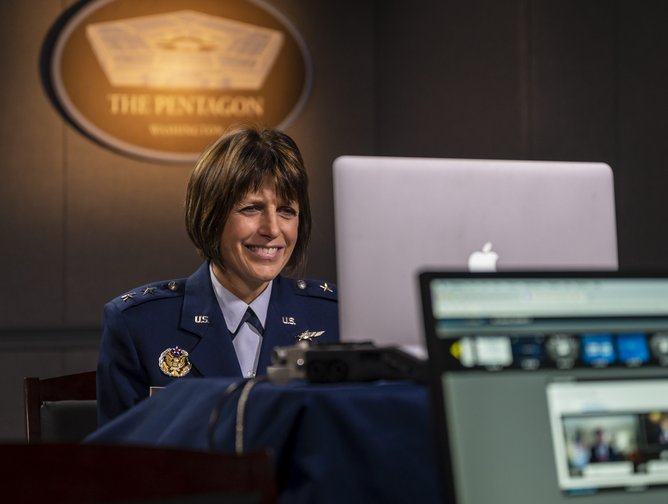There are not many government bodies that can claim to be born digital. The US Space Force is one of them. When the USSF was split out from the US Air Force in 2020, it decided to put science and technology “front and centre.” To inject a fresh perspective on how government agencies should work, USSF looked to the commercial sector, where agile practices are prized and digitally born startups use their inherent flexibility to challenge businesses many times their size.
“Our ability to work in space and be effective in space depends on software and data,” observed then-USSF Chief Technology Innovation Officer Maj. Gen. Kim Crider during an interview earlier this year. “Software development and software capabilities are a critical part of what we do.”
Adopting the cultural practices of small tech is just part of the story, though. There’s also a deliberate drive to have innovation driven by users. USSF has installed ‘combat development teams’: small, innovative teams that zero in on specific areas of a mission in a quest to understand what’s happening, how to add value, how to improve and how to apply digital technologies.
Small is beautiful
And size. Crider thinks, is no obstacle to success. “As a small service we want to take advantage of the fact that we have an opportunity because we’ve split off from the Air Force. We are now our own independent service establishing our own culture and our own way of doing things – building upon the greatness from which we came, but having the opportunity to think about this a little bit differently with new people, a lot of new recruits who are younger and bring those different perspectives.
“Our aspiration is to be born digital,” Crider continued. “How do we take a look at the existing processes and reinvent, reimagine, and transform them into a really digital approach? Digital engineering is a critical line of effort for us.”
That goal doesn’t mean that the Space Force thinks it has everything sussed. Model-based systems engineering that has to account for around the next 30 years of space exploration is fraught with guesswork about the sort of capabilities that will be needed. In the short term, at least, that means the delivery of digital artefacts alongside their physical counterparts.
E-satellites
“When we deliver a physical satellite,” Crider explains, “we bring with it what we call an e-satellite, a digital satellite. We started with a force design concept, a digital set of capability needs and then the digital twin becomes part of how we help sustain and operate that capability here on Earth. That entire digital thread is something that’s never been done before.
“The fact that we’re a small service means we can focus on building that kind of capability end to end, which is very powerful and something that we intend to leverage.”
As exciting as digital satellites are, Crider is quick to extinguish the idea that the fancy tech only makes it on to space-bound rockets. The idea has been extended to include a digital headquarters. Being small, USSF is looking at a flatter organisational hierarchy, enabling the stripping out of management layers with a range of collaborative tools and data environments. The resulting structure allows decisions to be made by personnel at the unit level right through to the four-star general level.
Arising from that is a need to build competency within the workforce, for which USSF is bringing in a generation of online learning and training, carefully managing the platforms to ensure a continuous stream of fresh content. “We have availability and access to those platforms through [the US Air Force’s] Digital University capabilities. How do we take that knowledge and enable individuals at the unit level to be part of these combat development teams so they can apply that knowledge in these modern DevSecOps environments and to do that rapid software development? All of that is part of our digital transformation.”
Digital awakening
It’s refreshing to see the machinery of government adapting so quickly. But the fact that it’s unusual is perhaps a result of digital technology being historically undervalued in the Department of Defense. “There has definitely been an awakening about how valuable these digital capabilities are to us, and that’s happened very, very quickly,” Crider admits. “We can create value within all our missions and we can integrate all of our services and capabilities much more effectively.
“It gives us the opportunity to create superhuman insight and understanding of what’s happening, and to do all of things toward which we had been striving for so long. We’re finally realising that if we pull all these pieces together we can reach a new level of performance and value-added creation.”
At its core, this endeavour is all about keeping not just on top of, but ahead of, the rising threat level in space. Some of the tools to operate on this new front are integrated and understandable data, AI, machine learning, natural language processing, software development, robotics, and autonomy.
Cyber-space
Cybersecurity is another core asset, for which USSF needs quantum computing to rapidly process information securely. Blockchain solutions are being used to securely trade information with partners. “It’s a whole other area where we think digital can help us think through our workflows and processes and secure those.”
But despite this army of new technologies, Crider remains adamant that the main piece of the work is a shift in culture. “As much as we value these technologies and see the benefits they can bring to us as human beings, we need to be able to adopt, integrate and diffuse these technologies throughout our organisations and make the most of them. We need to build that culture of innovation, that mindset that says ‘we want ways to try these new capabilities out’. Not everything is going to succeed, and that’s okay – as we try these things out in this more rapid, agile way, that will allow us to move faster and integrate. The whole process of learning is very human.”
A historic problem in the US military – as a whole – has been a lack of communication between different services. But that cultural barrier is also lifting, as the various branches of the military see the efficiencies of working together to experiment, innovate and implement in the digital realm. Crider says, “We have a regular battle rhythm of activities that go on where we are actively partnering across all of the services as part of this joint, all-domain command and control set of capabilities, which is one piece of an overall set of joint warfighting concepts coming out of the joint staff within the US military.”
It’s not restricted to digital implementations either, with a core aim being to establish these joint practices in the field, leading to efficiencies and increased success in operational missions. It’s a process of learning and adapting, too.
Buddying up
Partnerships are crucial to the Space Force’s work – there are large scale implementations in cloud computing, software development, software platforms, Platform-as-a-Service and data analytics. Being a small agency by design, partnerships have increased weight. “We were built to be a small service,” Crider acknowledges. “We make no apologies for being small. We’re designing ourselves to be lean, agile and innovative from the start and we’re going to capitalise on everything that being a small service allows us to do, including creating force-multiplying opportunities for ourselves by building strong partnerships with the science and technology community. We want to continue to partner with the big, the medium and the small startups because they’re the ones bringing all these great ideas to us and helping us to advance.”
Fostering and nurturing those partnerships is a big job in itself, but of paramount importance to the Space Force mission. “We want to be able to harness it,” Crider explains, “so we have a clear understanding of what our overall innovation portfolio is and what it looks like in the near, mid and long term, as well as those future far-reaching things that we don’t even know about yet, revolutionary areas where we see game-changing opportunities. It’s the future of science, so we need to be able to think about what these various types of partners bring in each of those areas to our evolutionary and revolutionary advantage. How do those different partners plan? Where does industry see the most opportunity to create value for itself? And then where do we come in with our science and technology portfolio? How does all that play into a coordinated and very visible portfolio of investment opportunities? We try to manage this explosion of innovation and interest in space with data, and we have to create our own data about how this overall portfolio is working.”
Learning and adapting are going to be crucial to USSF’s future. Space is a new frontier, as the Space Force looks to go to the moon and beyond, and understand the “entirety of the space domain.” Crider sums up that wider goal: “We’ve got to continue to advance our exploration of space, our ability to leverage space and our ability to really understand how deep space can support all of our objectives both from a military standpoint and across all of our global partnerships, so that we can make the most of this precious and valuable domain.”


